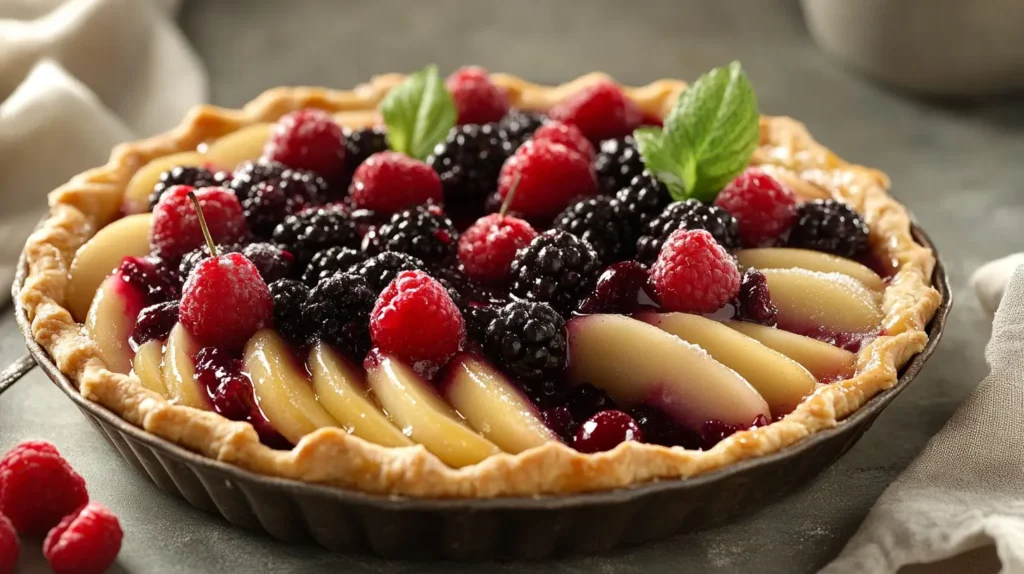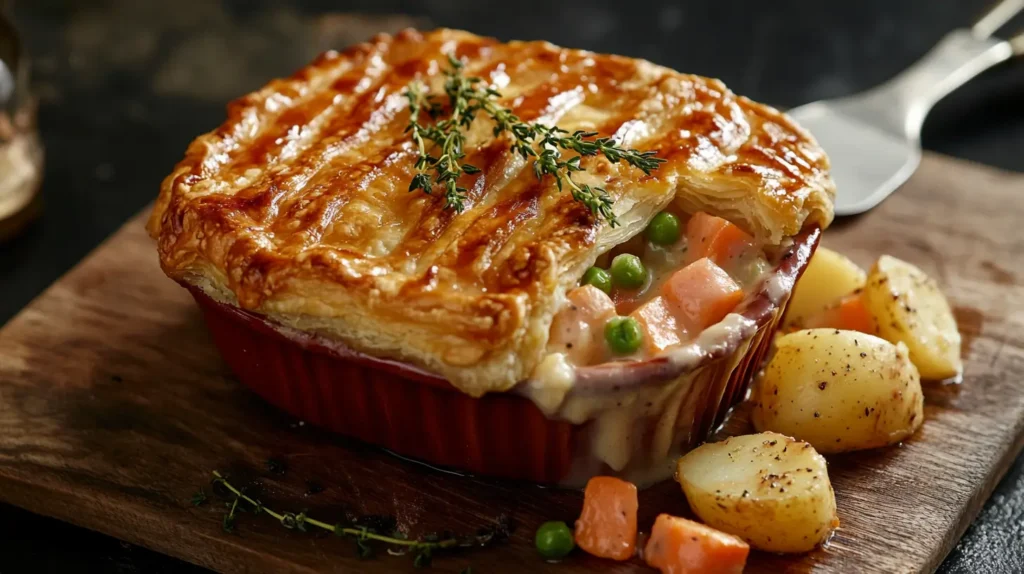Family Pie Recipe is a beloved tradition that turns simple ingredients into a masterpiece meant to be shared. Whether you’re a seasoned baker or trying your hand for the first time, creating a pie that everyone loves is a rewarding experience. From flaky crusts to rich fillings, family pies bring warmth to the lunch table and encourage connection. They’re versatile, satisfying, and the perfect dish for any gathering.

By following easy techniques, you can customize your pie to reflect family favorites or seasonal produce. Pies aren’t just food; they’re an opportunity to bond with loved ones. With the right approach, you can make any lunch occasion special by incorporating this timeless dish. Transitioning between different styles of pies and understanding their key elements ensures success every time. Let’s dive into what makes Family Pie Recipes an enduring favorite.

Table of Contents
The History and Origins of Family Pies
The Family Pie Recipe has a fascinating history that spans centuries. Its roots can be traced to ancient civilizations that baked simple versions of pies in clay ovens. Over time, pies became a staple in European kitchens, where they evolved into the savory and sweet variations we enjoy today. Each culture added its twist, making family pies as diverse as the families who cherish them.
In medieval times, pies were primarily savory and served as hearty meals. Sweet versions gained popularity later, especially in the 16th century. As families migrated, they brought their treasured recipes, adapting them to local ingredients. Today, pies symbolize togetherness and tradition, often featuring regional flavors or family-specific touches.
Understanding the origin of these recipes adds depth to the experience of baking them. It also inspires creativity, allowing you to incorporate traditional techniques into your Family Pie Recipe for lunch gatherings.
Key Ingredients for a Perfect Family Pie
Every successful Family Pie Recipe begins with high-quality, fresh ingredients. These components lay the foundation for a delicious and visually appealing pie. To achieve perfection, it’s crucial to strike a balance between the crust and filling.
- Flour: Choose all-purpose or pastry flour for a tender crust.
- Fat: Butter adds flavor, while shortening ensures flakiness.
- Liquid: Ice water binds the dough without making it tough.
- Filling: Sweet pies benefit from fruits like apples or cherries, while savory pies shine with meats, vegetables, and creamy sauces.
Other ingredients like spices, herbs, and a touch of sugar or salt enhance the flavors. The key is to respect the simplicity of the dish while allowing each ingredient to shine. By selecting the right components, you ensure that your Family Pie Recipe stands out at any lunch table.
Different Types of Family Pies Across Cultures
The versatility of Family Pie Recipes is evident in their global variations. Each culture has its unique take, reflecting local ingredients and traditions.
- British: Savory pies like steak and kidney or shepherd’s pie are staples.
- American: Classic apple or pecan pies dominate lunch menus.
- French: Quiche Lorraine combines eggs and cream for a savory delight.
- Mediterranean: Spanakopita uses phyllo pastry filled with spinach and feta.
- Asian: Curry pies and dumpling-style pastries offer bold flavors.
Exploring these variations broadens your culinary horizons and introduces exciting options to your lunch repertoire. Cultural twists add depth to your Family Pie Recipe while maintaining the essence of this cherished dish.
How to Choose the Right Pie Crust for Your Recipe
The crust is the backbone of any Family Pie Recipe. It sets the texture and flavor tone for the entire dish. Choosing the right crust depends on the type of pie you’re making and personal preferences.
- Flaky Crusts: Perfect for fruit and dessert pies, offering a melt-in-your-mouth experience.
- Shortcrust: Ideal for savory pies, providing a sturdy yet tender base.
- Phyllo Dough: Adds a crispy, light texture to pies like spanakopita.
- Graham Cracker Crusts: Excellent for no-bake or creamy pies.
Consider the filling’s moisture level and baking time when deciding. Pairing the correct crust ensures that your Family Pie Recipe achieves the ideal balance between taste and texture.
Sweet vs. Savory Family Pie Recipes
The choice between sweet and savory Family Pie Recipes often depends on the occasion and your guests’ preferences. Both have their own appeal and versatility.
Sweet pies, such as peach or berry, provide a comforting finish to lunch. They pair well with whipped cream or a scoop of ice cream. Savory pies, like chicken pot pie or mushroom and leek tart, are hearty enough to serve as the main course.
Experimenting with these two styles allows you to cater to diverse tastes. Incorporating seasonal ingredients ensures that your pies feel fresh and exciting, no matter which direction you choose.
Step-by-Step Guide to Baking a Classic Family Pie
Mastering a classic Family Pie Recipe is simpler than it seems. Follow these steps for a foolproof result:
- Prepare the Dough: Combine flour, butter, and a pinch of salt, adding ice water until the dough comes together. Chill for 30 minutes.
- Roll Out the Crust: Roll the dough evenly and fit it into your pie dish. Trim the edges.
- Prepare the Filling: Cook savory ingredients or macerate fruits with sugar and spices for sweet pies.
- Assemble the Pie: Pour the filling into the crust, then add the top layer or lattice design.
- Bake: Place the pie in a preheated oven and bake until golden brown.
This process ensures your pie is both visually appealing and delicious, making it the highlight of any lunch spread.
Tips for Making the Flakiest Pie Crust
Achieving a flaky crust is essential for a standout Family Pie Recipe. Here are some expert tips:
- Use very cold butter or shortening.
- Avoid overmixing the dough to prevent toughness.
- Chill the dough before rolling it out.
- Roll the dough gently and evenly.
- Bake at the right temperature to ensure crispness.
These techniques help create a crust that’s both tender and structurally sound, complementing any filling you choose.
Creative Fillings for Unique Family Pies
A Family Pie Recipe becomes truly special with creative fillings. Thinking outside the box can lead to combinations that surprise and delight your guests.
- Sweet Fillings: Try tropical fruits like mango or passionfruit mixed with traditional apples.
- Savory Fillings: Blend unexpected ingredients like roasted squash with goat cheese or caramelized onions with gruyere.
- Fusion Flavors: Combine elements from different cuisines, such as curry spices in a chicken pie.
Experimentation is the key to keeping your recipes exciting. Don’t be afraid to test new ideas while honoring the comforting tradition of family pies.
Seasonal Family Pie Recipes for Every Occasion
A Family Pie Recipe can be tailored to match any season, making it a versatile dish for year-round enjoyment. Seasonal pies highlight fresh, in-season ingredients, ensuring optimal flavor and presentation. In spring, consider a lemon meringue or asparagus and goat cheese pie. Summer lends itself to vibrant options like peach pie or zucchini tart. For fall, nothing beats a classic pumpkin pie or a hearty beef and root vegetable pie. Winter calls for comforting options like pecan pie or chicken pot pie with creamy sauces.
By aligning your recipes with seasonal produce, you not only celebrate the flavors of the time but also ensure cost-effective and sustainable cooking. These recipes can elevate your lunch gatherings and bring a sense of occasion to the table.
How to Customize Family Pies for Dietary Preferences
Adapting a Family Pie Recipe to suit dietary preferences ensures everyone can enjoy this beloved dish. For gluten-free options, substitute regular flour with almond or rice flour for the crust. Vegan pies can replace butter with plant-based fats and use flaxseed or aquafaba as egg alternatives.
For those reducing sugar, natural sweeteners like honey or maple syrup work well in sweet pies. Low-carb enthusiasts might enjoy a crustless savory pie, using layers of vegetables instead of traditional dough. Lactose-intolerant guests will appreciate plant-based milk and cheese in fillings.
Customizing pies not only broadens your cooking skills but also ensures inclusivity. These small adjustments make your Family Pie Recipe accessible while maintaining its delicious essence.
Traditional Family Pie Recipes Passed Down Through Generations
Traditional Family Pie Recipes are a treasure trove of culinary heritage, often passed down through generations. These recipes carry stories, memories, and flavors that connect families to their roots. Classics like apple pie with a lattice crust or a chicken and mushroom pot pie evoke a sense of nostalgia and comfort.
What makes these recipes special are their unique touches, such as secret spice blends or family-specific techniques. Some families may have a recipe for a hand-kneaded crust, while others rely on heirloom filling combinations.
Preserving these traditions honors your family’s culinary history while allowing you to share it with others. Baking a traditional Family Pie Recipe is not just about the food; it’s about celebrating the connection it represents.
Decorating Tips for Beautiful Family Pies
Presentation plays a big role in the appeal of a Family Pie Recipe. Decorating your pie with creativity enhances its visual impact and makes it the star of the lunch table.
- Use a lattice crust for a classic, elegant look.
- Create seasonal patterns like leaves for fall or flowers for spring.
- Add cut-out shapes using pie crust scraps for a playful touch.
- Brush the crust with an egg wash for a golden, glossy finish.
- Sprinkle sugar or seeds on the crust for texture and flavor.
With a few simple techniques, your pie will not only taste incredible but also impress everyone with its aesthetic appeal.
Common Mistakes to Avoid When Baking Family Pies
Baking a Family Pie Recipe can sometimes lead to pitfalls, but with a bit of care, these can be easily avoided. One common mistake is overworking the dough, which results in a tough crust. Another is skipping the step of chilling the dough, leading to a less flaky texture.
Using too much or too little filling can also affect the pie’s balance. Overfilled pies might overflow, while underfilled ones can feel incomplete. Additionally, not pre-cooking certain fillings, like apples or meats, may result in uneven cooking.
By paying attention to these details, you can avoid mishaps and produce a pie that’s as delicious as it is satisfying.
Serving Suggestions and Pairings for Family Pies
A Family Pie Recipe becomes even more enjoyable when paired with complementary sides or beverages. For sweet pies, serve with whipped cream, custard, or a scoop of vanilla ice cream. Savory pies pair wonderfully with fresh salads, roasted vegetables, or a bowl of soup.
Drinks can also enhance the experience. Coffee or tea is perfect for sweet pies, while savory pies go well with light wines or sparkling water. These thoughtful pairings complete the meal and ensure a well-rounded dining experience for lunch gatherings.
Storage and Reheating Tips for Leftover Family Pies
Properly storing a Family Pie Recipe ensures that leftovers remain fresh and delicious. For sweet pies, wrap them tightly in plastic wrap or foil and store at room temperature for up to two days or in the fridge for longer. Savory pies should always be refrigerated and consumed within three to five days.
To reheat, use an oven set at 350°F (175°C) to preserve the crust’s crispness. Avoid microwaving, as it may make the crust soggy. Pies can also be frozen for up to three months; just be sure to thaw them in the fridge before reheating.
These tips help extend the enjoyment of your pies while maintaining their quality.
Why Family Pies Bring People Together
The beauty of a Family Pie Recipe lies in its ability to bring people together. Sharing a pie creates a sense of community, as everyone gathers around to enjoy its comforting flavors. From preparing the pie as a group to savoring the final dish, pies foster collaboration and conversation.
They are versatile enough to accommodate a variety of tastes, ensuring that no one feels left out. Pies also carry sentimental value, often tied to special occasions or family traditions. Baking and sharing a pie isn’t just about the food; it’s about creating lasting memories that strengthen bonds.
FAQs
How long does a family pie take to cook?
The cooking time for a Family Pie Recipe depends on its size and filling. On average, most pies take about 45–60 minutes to bake in a preheated oven at 375°F (190°C). Sweet pies with fruit fillings may cook slightly faster than savory pies, especially if the filling is pre-cooked. It’s essential to keep an eye on the crust, ensuring it turns golden brown while the filling bubbles gently.
What are the 4 types of pie fillings?
There are four main types of pie fillings that can transform any Family Pie Recipe:
- Fruit Fillings: Apples, cherries, or berries are popular for sweet pies.
- Custard Fillings: Smooth mixtures of eggs, milk, and sugar, as found in pies like pumpkin or coconut cream.
- Savory Fillings: Ingredients like chicken, vegetables, and cheese for hearty meals.
- Nut Fillings: Often sweetened, like pecan or walnut pies, providing a rich, crunchy texture.
What to have with a family pie?
Pairing a Family Pie Recipe with the right sides or toppings elevates the meal. For sweet pies, consider serving them with whipped cream, a drizzle of caramel, or a scoop of vanilla ice cream. Savory pies pair well with side dishes like fresh green salads, roasted vegetables, or creamy mashed potatoes. Drinks such as iced tea, lemonade, or a light white wine complement the flavors beautifully.
How long should my pie be in the oven?
The time your Family Pie Recipe spends in the oven depends on the recipe specifics, but most pies bake for 40–60 minutes at 350°F to 375°F (175°C to 190°C). For best results, check the crust for a golden-brown color and ensure the filling is hot and bubbling. If the edges of the crust brown too quickly, covering them with aluminum foil can prevent burning.
Conclusion
The Family Pie Recipe is more than just a meal; it’s a cherished tradition that combines simplicity, flavor, and connection. Whether you’re baking a seasonal pie, honoring a family recipe, or experimenting with new fillings, pies are a versatile addition to any lunch table. By focusing on fresh ingredients, thoughtful preparation, and creative touches, you can craft a dish that resonates with everyone.
Family pies celebrate togetherness and the joy of sharing food, making them a timeless favorite. So, gather your ingredients, roll out your crust, and create a pie that brings smiles and memories to your loved ones.
Looking for more creative ideas? Try our Pecan Pie Dip Recipe for a sweet twist or our unique Pickle Pie Pizza Recipe for a savory dinner treat. Both are must-tries!
